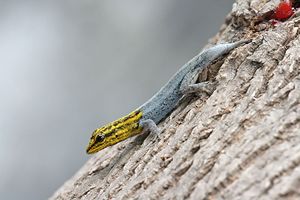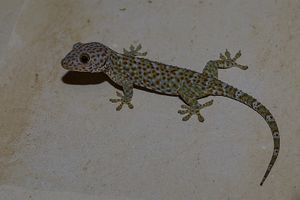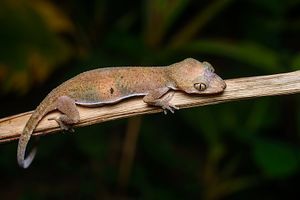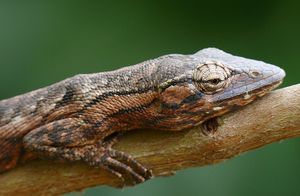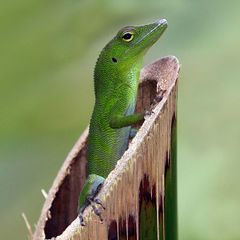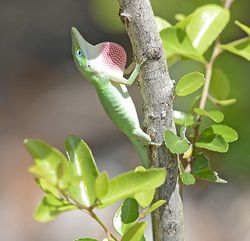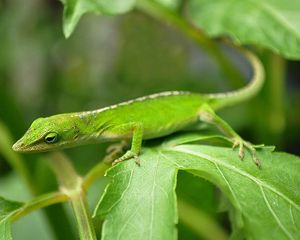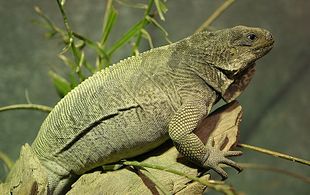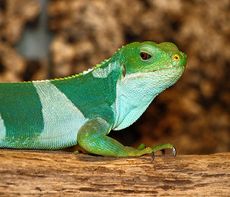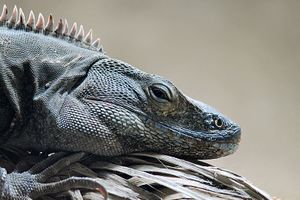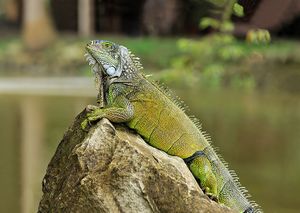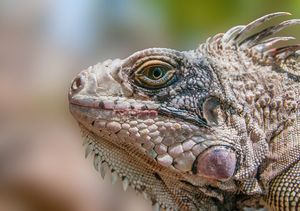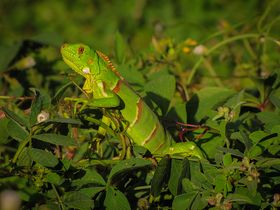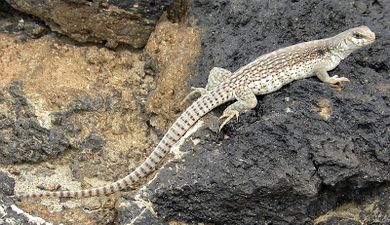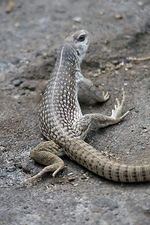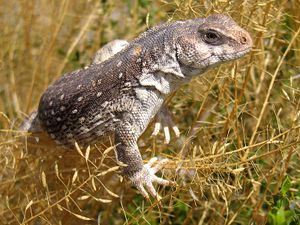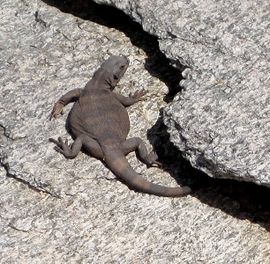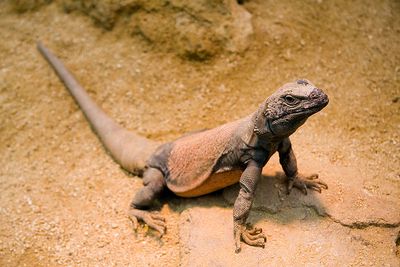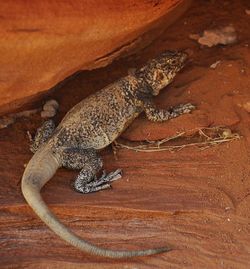Herpetology/Lizards
This page is incomplete. |
This page contains information on lizards on the Herpetology List. For more general information about the event, see Herpetology.
Suborder Lacertila/Sauria (lizards)
Lacertila/Sauria belongs to Order Squamata.
| Etymology | James Macartney gave lizards the name Sauria, from the French name "sauriens". |
|---|---|
| Physical Appearance | The size of lizards ranges from a few centimeters for chameleons to almost 10 ft for the largest living lizard, the Komodo dragon. Most lizards have elevated heads, short necks, four limbs (but some have none), and long tails. Scales of lizards are made of keratin. This helps protect the lizard from the environment and reduce water loss. Lizards have leathery skin and it is shed as the organism grows. Unlike snakes, lizards shed their skin in pieces. Most lizard species have pleurodont teeth, but some have acrodont teeth. Lizards have rather long tongues that can be extended outside the mouth and some have forked tongues. They are used mainly to sense the surrounding environment through the vomeronasal organ. Geckos, anoles, and chameleons have adhesive pads on their toes, composed of setae. |
| Life Cycle | Most lizards are oviparous but some can be ovoviviparous or viviparous. The female lizard lays eggs on the ground or under various things like rocks, logs, buildings, etc. Clutch size varies widely from 4-5% of a female's body weight to 40-50%. Cluches can contain a few large eggs or many smaller eggs. Eggs have a leathery shell to retain water. Incubation period differs between species. Some species, specifically whiptails, are parthogenic (reproduce without a male). Sex determination can be temperature-dependent. |
| Ecology, Habitat and Diet | Habitat: Most prefer warm, tropical climates but can live in many different habitats, including the sea. Diet: Most lizards are carnivorous or insectivorous but can be herbivorous or omnivorous. Many sit and wait for their prey to come but some are active foragers. Prey include ants, crickets, beetles, termites, moths, spiders, grasshoppers, snails, fish, frogs, birds, mammals, repiles, eggs, water buffalos, flowers, leaves, stems, fruits, algae, and kelp. |
| Behavior and Locomotion | Locomotion: Lizards with limbs can walk like cats and dogs. Some lizards can run on their hind legs, and others can 'stand up' on their hind legs and tail. Some speices can glide up to 60 meters. Others can climb up walls, and still others can run across water. Senses: Lizards can see, touch, smell, and hear, but depending on the species and how they live, the balance between the senses differs significantly. For example, skinks, who live mainly underground, rely on smell and touch, while geckos that live in trees rely on their sight. Lizards do not have external ears and instead of a circular opening in their head. Lizards also have a vomeronasal organ that allows them to decet pheromones. Their tongue takes scents from the environment to the vomeronasal organ. Some lizards have a praietal eye that can sense changes in light and detect movement. Most lizards are active during the day so that they can warm up from the heat of the sun. Many lizard males are territorial and fight other males in different ways. Communication: There are many ways in which lizards communicate. One is through coloration - this is seen in anoles. They have brightly colored dewlaps that help attract females. Some lizards have mating calls, but that is less common. |
| Conservation Status and Efforts | Lizards are not extinct. |
| Distribution | Lizards can be found everywhere except near the north pole and in Antarctica, as well as some islands. |
| Miscellaneous Information | Chameleons can move their eyes in different directions, so they can see forwards and backwards at the same time. Some lizards are venomous, including the Gila monster, Mexican beaded lizard, and the Komodo dragon. Symptoms can vary depending on the type of lizard but can include loss of consciousness, pain, extensive bleeding, drops in blood pressure, and less blood clotting. Some parts of lizard venom is being considered for medical purposes (see section on Gila monsters for more information). |
Family Gekkonidae (gecko lizards)
The family Gekkonidae contains over 950 species and 64 genera of geckos, including the most common gecko species.
Family Polychridae (anoles)
This family contains thirteen genera and over 650 species.
Genus Anolis (anoles)
The genus Anolis contains almost 400 species and is the largest and most diverse reptile genus.*
Family Iguanidae (iguanids)
This family of iguanids contains over 40 genera and about 700 species.
Genus Iguana (green iguana)
Genus Dipsosaurus (desert iguana)
Genus Sauromalus (chuckwalla)
This genus of iguana contains 6 species.
Family Crotaphytidae (collared lizards)
This family of lizards contains 2 genera and 12 species.
| Alternate names | (alternate names) |
|---|---|
| Etymology | (etymology) |
| Physical Appearance | Size: Collared lizard size depends on the species, ranging from 100-145 SVL. Color: Some species' females are brightly colored all the time, and the females' orange spots brighten before oviposition and fade between egg-laying. Teeth: Their teeth are pleurodont, unlike iguanas. Other: Granular scales. These lizards have femoral pores, like many other lizards. Their interparietal scales are smaller than their ear openings. |
| Life Cycle | Female collared lizards lay 1-2 clutches of four to eleven eggs during June under large rocks or in rodent burrows. The eggs have an incubation period of about 2 months. |
| Ecology, Habitat and Diet | Collared lizards live in deserts. They also inhabit rock outcroppings. They are carnivorous, eating insects and smaller lizards. |
| Behavior and Locomotion | Collared lizards can run very fast across deserts and plains. When threatened, collared lizards make squealing sounds. Male collared lizards are very territorial. |
| Conservation Status and Efforts | (conservation status/efforts) |
| Distribution | Collared lizards can be found in southwestern US and northern Mexico. |
| Miscellaneous Information | The family Crotaphytidae was previously considered a subfamily of Iguanidae. |
Family Phrynosomatidae
This family contains 9 genera and over 120 species.
| Alternate names | (alternate names) |
|---|---|
| Etymology | (etymology) |
| Physical Appearance | Size: Phrynosomatidae lizards are on the smaller side, with most being less than 10 cm SVL. Teeth: These lizards have pleurodont teeth and do not have pterygoid teeth. Color: Some species have brightly colored females. Male colors depend on social behavior. Other: Lizards in the genera Uma, Callisaurus, Holbrookia, and Phrynosoma do not have lacrimals and postfrontals. All lizards in this family have a reduced clavicular flange, a sink-trap nasal apparatus, a larger posterior lobe of the hemipenes, and completely divided m. retractor lateralis posterior (a muscle). |
| Life Cycle | Depending on the species, lizards in this family are either oviparous or viviparous. Viviparous species are more common at high elevations. |
| Ecology, Habitat and Diet | Many lizards in this family live in hot, sandy deserts, but some species live in rocky deserts or near moist forests. The short-horned lizard lives in prairies or sagebrush. |
| Behavior and Locomotion | These lizards can squirt blood at threats as a defense. They are solitary and females reject males by back-arching and side hopping. |
| Conservation Status and Efforts | Most lizards in this species are designated as 'least concern'. |
| Distribution | These lizards can be found from Panama to south Canada. |
| Miscellaneous Information | See individual genera for more information. |
Genus Sceloporus (spiny lizards)
This genus contains 22 species with several subspecies.
| Alternate names | Fence lizards, scaly lizards, swifts. |
|---|---|
| Etymology | The common name comes from the spiny scales on the lizard's body. |
| Physical Appearance | Size: Spiny lizard SVL ranges from 2.25-5/25 inches (63-138 mm). Color: All lizards in this genus can change color depending on the temperature. They are darker when it is cold and lighter when they are at the optimal body temperature. Generally, both males and females have gray or brown scales and can be striped and/or marked with rearward directed arrows. Their stomachs are of a lighter color than the rest of their bodies. Most males have blue patches on the sides and throat. Females have orange or red heads during breeding season. Both sexes have a dark collar on some species. This coloration is used for both mating and territorial displays. |
| Life Cycle | The female lizard lays 4-24 eggs during the summer. The eggs take 60-75 days to hatch. |
| Ecology, Habitat and Diet | Habitat: The habitat of lizards in this genus depends on the species. Some are arboreal, some live near rocks, some live in sagebrush, scrub, and prairie. Diet: Spiny lizards eat insects including ants, beetles, and caterpillars. They also eat spiders, centipedes, and small lizards. |
| Behavior and Locomotion | Spiny lizards are diurnal and males are territorial. As a form of territorial display, males do push-ups, like many other lizards. Spiny lizards hibernate in late fall and winter. They can and will probably bite when threatened. |
| Conservation Status and Efforts | (conservation status/efforts) |
| Distribution | Spiny lizards are found in North and Central America. In the US, they are found from Southern New York, southern South Dakota, northern Washington, South Florida, the Gulf States, and near the Mexican border. |
| Miscellaneous Information | Spiny lizards are darker when cold to absorb more heat and lighter when hot to reflect sunlight. |
Genera Cophosaurus and Holbrookia (earless lizards)
| Alternate names | (alternate names) |
|---|---|
| Etymology | (etymology) |
| Physical Appearance | As the name suggests, the lizards in these genera have no external ear openings to prevent sand from entering while they dig holes. However, they can still hear. Size: The size of earless lizards range from 3-7 inches. Males are larger than females. Color: Males have two black stripes near their hind legs, while females have one black stripe behind each thigh. The scales around the stripes are blue/green. Females have pink throats and flanks if they are pregnant. Both males and females are light brown with orange, yellow, and white specks. These dots are helpful for camouflage. Feets: Their front legs are shorter than their hind legs and their toes are long.Other: Earless lizards have up to 27 femoral pores and two throat folds. They have a 'blood sinus' at the top of their heads that help them both defend themselves and warm up faster. Their ideal body temperature is 35-40 degrees Celsius. |
| Life Cycle | Earless lizards mate during the spring. Eggs are laid from March to August, and the incubation period is about 50 days while the gestation period is about 30 days. The eggs are buried by the female in heated sand. After they bury the eggs, both males and females look for other partners. Females lay 1-3 clutches, each 1-10 eggs. Females stop growing after 5 months and males stop growing after 1 year. Males and females begin reproducing after they are 5g and 3g, respectively. |
| Ecology, Habitat and Diet | Habitat: These lizards live in semi-arid areas and grasslands. They can also be found in desert regions and on steep slopes, rocky soils, or near desert plants. Diet: Earless lizards eat arthropods like butterflies, moths, beetles, grasshoppers, insects, and spiders. |
| Behavior and Locomotion | Earless lizards are diurnal and can tolerate high heats. They hibernate during the winter and fall. Defense: Earless lizards raise and wag their tails. They can also squirt blood out of the 'blood sinus' at the top of their heads. The males are territorial and they compress their bodies, bob their heads, and do push-ups to show this. These actions are also done to attract females. When running away from predators, these lizards curl their tail to display black bands, leading the predators to attack the tail first instead of the body. This is helpful because the tail can fall off. |
| Conservation Status and Efforts | They are not threatened but the populations could be affected by habitat loss and degradation. |
| Distribution | Earless lizards can be found in southwestern US and Mexico. In the US, they live in Texas, Arizona, New Mexico, Utah, Colorado, Kansas, Oklahoma, Nebraska, South Dakota, and Wyoming. In Mexico, they live in Sonora, Chihuahua, Coahuila, Sinaloa, Durango, Zacatecas, San Luis Potosi, Nuevo Leon, Tamaulipas, and Veracruz. |
| Miscellaneous Information | Earless lizards live for about 3 years. High body temperatures allow them to digest larger foods. Earless lizards are preyed on by rattlesnakes, roadrunners, and nighthawks. |
Genus Uma (fringe toed lizards)
| Alternate names | Not exactly alternate names, but there are many variations of spelling - ex. fringe-toed lizards, fringe toe lizards, etc. |
|---|---|
| Etymology | The common name comes from the fringed toes of the lizard. |
| Physical Appearance | Size: Size of fringe toed lizards depends on the species, with adults ranging around 7-13 cm. Males are larger than females. Color: Fringe toed lizards are brown and tan. This helps them camouflage, as they live in the sand. Their backs are marked with what looks like brown dots inside larger white dots. Both males and females in some species have pink sides during mating season. Feets: These lizards have elongated scales on their hind toes that form a sort of fringe, hence the name. The fringe allows the lizard to run across the sand quickly without sinking into dunes or sliding around. Other: To prevent sand from getting inside the body, fringe toed lizards have upper jaws that overlap the lower jaws, nostrils that can be closed at will, flaps that can be closed around the ears, and upper and lower eyelids. |
| Life Cycle | Males, during mating season, rapidly nods his head and waves each of his front legs as he approaches a potential mate or another male. If the female does not like him, she will display rejection by running away or lifting and waving her tail to the male. Mating season is from mid-April to mid-August. Each clutch includes 2-4 eggs, but the number of clutches laid per year is unknown. The average is size is around 22 by 12 mm. Age at sexual maturity for both males and females is 2 years. |
| Ecology, Habitat and Diet | Habitat: These lizards live in areas with loose sand. Some species are very particular to the size and compaction of the sand. For example, the Coachella Valley Fringe toed lizard (Uma inornata) only lives in areas with windblown sand that is between 0.1 mm and 1 mm in diameter. Diet: Fringe toed lizards eat insects such as ants, beetles, grasshoppers, and caterpillars. They also eat flower buds, stems, leaves, and seeds. When they shed, they will eat their own skin. They will also eat the skin of other animals. Some studies show that fringe toed lizards can sense insects moving underneath the sand. |
| Behavior and Locomotion | Fringe toed lizards like to sleep in burrows and stay there during the winter. Burrows are also used for protection from predators. If they are forced to live together in a confined area, fringe toed lizards will develop a hierarchy with dominance established through aggression and fighting. Establishing dominance begins with two lizards presenting their backs to each other while facing opposite directions. Then, the two will raise their bodies, increase surface area by extending the dewlap and the sides of the belly, and do some push-ups. If this leads to fighting, the two lizards will start walking in circles, periodically lunging at the other and trying to avoid being bitten. The lizard that 'loses' will flatten its head and body while holding its legs close to its sides. Defense: When threatened, fringe toed lizards will run away hide in a burrow, or dive under the sand. Then can run on its hind legs at high speeds. |
| Conservation Status and Efforts | Most species in this genus are of least concern, but the Coachella Valley fringe toed lizard is endangered due to its small range and habitat loss. |
| Distribution | Fringe toed lizards can be found throughout southeast California and southwest Arizona and into northwest Sonora and northeast Baja California. |
| Miscellaneous Information | Because the Coachella Valley fringe toed lizard was considered threatened, the Coachella Valley Preserve System was made in 1986. |
Genus Urosaurus (tree lizards)
There are 10 subspecies within this genus.
| Alternate names | Ornate tree lizard |
|---|---|
| Etymology | (etymology) |
| Physical Appearance | Size: Tree lizards are on the small side - only around 3.8-5.9 cm. There is no sexual dimorphism in terms of size. Color: They are marked with crossbars or blotches that are black, dark brown, tan, or gray, depending on the habitat. They have two bands of larger scales down their backs, and the base of their tails is a rusty brown color. Males have bright patches on their stomachs. The sides of the stomachs are blue or blue-green and look metallic. Males may also have a green, blue-green, orange, or yellow dewlap. Females have a white stomach and a white, orange, or yellow throat. There have been 9 color types for males documented. The majority of males either have a blue spot in the center of a larger orange patch on the dewlap or have no blue spot (just an orange patch). The males with blue are more aggressive. |
| Life Cycle | Tree lizards are oviparous. The incubation period is around 30 days. The mating season is from March to August. After holding the eggs for about two weeks, females lay 1-6 clutches with 2-13 eggs per clutch. Eggs are laid under rocks, in the dirt, or underground. Two days before laying eggs, the female lizard digs a hole 9-11 cm deep, taking lots of breaks like me when I'm studying for a test. |
| Ecology, Habitat and Diet | Habitat: Tree lizards live in forests with mesquite, oaks, and cottonwoods at up to 2770 meters above sea level. They also live in rocky terrain, on sides of buildings, and near streams, rivers, and other bodies of freshwater. They can also be found in deserts with trees or shrubs. Diet: Tree lizards eat spiders, beetles, ants, termites, other insects, and insect larva. |
| Behavior and Locomotion | Tree lizards are territorial but their territories sometimes overlap with other tree lizard territories. In these cases, there will be one dominant male (usually the heaviest), but no dominant female among the females in the territory. In one territory there are usually one male and multiple females. The male will mate with all of the females in his territory. When the number of females decreases significantly in a male's territory, the male will leave and go out to look for a better territory. They hibernate in groups and start hibernating as early as mid November. They emerge from their hibernation around February. They look for food at dawn. Unlike other lizards, tree lizards do not use chemicals to communicate. When threatened, they will climb a tree or hide under rocks, under vegetation, or in small cracks. |
| Conservation Status and Efforts | Tree lizards are listed as 'Least Concern' under the IUCN Red List. There are no threats to the tree lizard populations. |
| Distribution | These lizards are found in southeastern California, southern Nevada, Utah, western Colorado, Arizona, New Mexico, southwest/central Texas, Sonora, Sinaloa, Chihuahua, and North Coahuila. |
| Miscellaneous Information | Tree lizards live for less than 3 years. The annual adult survivorship is around 11%. They are preyed on by owls, snakes, and other birds. Tree lizards are used to study physiological changes during fight-or-flight responses. Some scientists have suggested that tree lizards have multiple male genders. This is shown through the fact that males have different dewlap colors and these different dewlap colors correspond to different hormonal profiles. Scientists believe that high levels of progesterone on the day a male hatches and higher testosterone levels as a juvenile leads to a male with an orange and blue dewlap, while low levels of both lead to a male with only orange (see 'Color' for details about dewlap color). |
Genus Uta (Side blotched lizards)
| Alternate names | (alternate names) |
|---|---|
| Etymology | (etymology) |
| Physical Appearance | Size: These lizards grow to an average of about 6 inches including the tail. Males are slightly larger. Scales: These lizards have smaller smooth granular scales on the back and larger scales on the head and limbs. Color: Color various from lizard to lizard. Some can have a pattern that distinguishes them from other lizards, while others could be unpatterned. The stomach area is white to gray. However, both males and females have a blotch on their sides. See "behavior" for more info on side-blotched lizard coloring. Tail: The tail of this lizard is long and thin. Tail length is very important for side-blotched lizards because they determine hierarchies. Because of this, males are less likely to cut off their tail when threatened. |
| Life Cycle | Breeding season is from April to June. Eggs can hatch as early as late May. Females lay clutches that contain an average of 5.1 eggs and a maximum of 9 eggs. |
| Ecology, Habitat and Diet | Habitat: Side-blotched lizards live in areas such as desert, coastal scrub, chaparral, grass, juniper, pine-juniper, Joshua tree and valley-foothill. Most areas are arid or semi-arid with bushes/small trees. The soil may be sandy, gravelly, or rocky. Diet: These lizards eat arthropods like insects, spiders, and sometimes scorpions. Studies have found that feeding behaviors can relate to reproductive behavior. |
| Behavior and Locomotion | Now we get to talk about the rock-paper-scissors effect. The rock-paper-scissors effect explains how side-blotched lizards reproduce. Males have three specific morphs. The first of the three are the orange-throated males. They are the most dominant and have high testosterone. They control areas with multiple females. The second are the yellow stripe-throated males. They do not have a territory to defend, but they mate females on the orange-throated male's land when they're not looking. The third are blue-throated males. They are less aggressive and they guard only one female. They are able to fight yellow males but cannot fight off orange-throated males. The two morphs of female side-blotched lizards are orange-throated females and yellow-throated females. Orange lay lots of small eggs and are territorial. Yellow lay fewer but larger eggs and are not as territorial. 'Why is this called the rock-paper-scissors effect?' you might ask. The three male morphs all have an advantage over one other morph but a disadvantage over the other one, like how in rock-paper-scissors the game™ one hand signal has an advantage over another but is disadvantaged to another. Fun fact: Yellow males may turn into a blue male when a dominant male dies nearby. Though they do develop blue patches, they look different from the blue patches of the original blue male. The side-blotched lizard is diurnal. |
| Conservation Status and Efforts | This species is considered to be "Least Concern" because of its large populations. |
| Distribution | Side-blotched lizards are one of the most commonly seen lizards in the deserts of western North America and northern Mexico. |
| Miscellaneous Information | Predators of side-blotched lizards include snakes, birds, and larger lizards like collared lizards, leopard lizards, spiny lizards, and roadrunner. Side-blotched lizards can be infected by parasites such as nematodes and cestodes in the intestines, and members of the Apicomplexa in the blood. |
Genus Phrynosoma (horned lizards)
This genus contains 22 species and 3 of the species have subspecies.
| Alternate names | Horny toads, horntoads |
|---|---|
| Etymology | The common name is because of the 'horns' the lizard has on its head and back. Phrynosoma, the genus name, means 'toad-bodied'. Like toads, they move more slowly than some other lizards. |
| Physical Appearance | Horns: The horn-like things on the back of the head are actual horns, but the horn-like things on the back are not. They are modified scales that prevent water loss through the skin. Body: The horned lizard has a flattened, wide body. Color: The back and head are gray, with tan, brown, red, and/or yellow markings. The stomach area is a yellowish gray. Horned lizards are capable of changing their colors from light to dark in just a few minutes. |
| Life Cycle | The mating season is from late April to July, peaking in June. Eggs are laid in late July or early August. Horned lizards living in the northern parts lay their eggs later than those living in the south. Some species retain their eggs until they hatch, and others bury the eggs in the sand. The number of eggs per clutch depends on the species, but the average is around 15. Parental care has not been observed in this genus. The life expectancy is from 5 to 8 years in the wild. |
| Ecology, Habitat and Diet | Habitat: Horned lizards live in hot, dry, sandy environments. Some are found in deserts while others may be found living in the mountains. Diet: These lizards eat slow-moving insects and spiders, sowbugs, ticks, and sometimes butterflies and insect larvae. Ants are a very big part of this lizard's diet. When looking for food, the horned lizard will wait and catch prey with its tongue instead of chasing after it. |
| Behavior and Locomotion | Horned lizards have many interesting means of defense. One is camouflage. Their color allows them to hide into the background of their habitat. If this does not work for whatever reason, the lizards will puff up their bodies to look bigger and to show off their horns and make the predator think that they cannot be swallowed. At least 8 species of horned lizards can squirt and aim blood from their eyes. The stream of blood can go a distance of up to 5 feet. This is done by restricting blood flow to the head, increasing pressure in blood vessels near the eyes and causing tiny ruptures. In addition to confusing predators, the blood tastes bad to dogs, cats, and other related threats. Before, researchers thought that this chemical was added to the blood after it was already circulating in the body, but recent research shows that the chemicals are already in the body before squirting.
During the fall and winter, horned lizards hibernate by burying themselves in the sand. They are diurnal and spend the first part of their day basking to raise their body temperature to a specific temperature. After eating, they will hide in the shade until the temperature outside becomes bearable again. When it is time to go to sleep, horned lizards stick their nose in the sand and wiggle around to create a small burrow for themselves. |
| Conservation Status and Efforts | Horned lizard populations are declining even though there are now laws in place to prevent this. Loss of habitat, human eradication of ant populations needed for food, and displacement of said ant populations due to invasive species are affecting Texas horned lizard populations. This species of horned lizard has already disappeared from half of its geographic range. Because of this, the Center for Biological Diversity petitioned to have the Texas horned lizard put on the endangered species list. |
| Distribution | Horned lizards are found in the western US and Mexico, from Arkansas to the Pacific and from British Columbia to Guatemala. |
| Miscellaneous Information | The Horned lizard is the official state reptile of Wyoming and Texas. It is also a mascot of Texas Christian University. In my opinion, the mascot is a little scary. I think it's the eyes. |
Family Lacertidae (wall lizards)
This family contains over 300 species in 39 genera.
| Alternate names | True lizards, lacertas |
|---|---|
| Etymology | (etymology) |
| Physical Appearance | Size: Most wall lizards are less than 9 cm long SVL. The largest living species, Gallotia stehlini, can be up to 46 cm long. Tail: Long, about 2/3 of the entire body length. Scales: They have large scales on their head as well as osteoderms on the back and underside. The stomach area has rectangular scales that are reddish, pink, or orange. Color: The color of tree lizards are usually brown or grey with some green. The pattern depends on the species, and males and females have different patterns even within species. Some common patterns include spots and stripes, usually white on a brown-grey background. |
| Life Cycle | At least 8 species are parthenogenetic, and 3 species are viviparous. The breeding season is during the spring. Eggs hatch about 6-11 after mating, during the summer. Females can lay between 2-10 eggs per clutch, usually between rocks or broken walls. |
| Ecology, Habitat and Diet | Habitat: Wall lizards in Europe live in forest in scrub habitats. Those in Asia usually are found in grasslands and deserts. Lizards living in Africa live in rocky, arid areas. Diet: The wall lizard runs and jumps to catch food, including flies, moths, butterflies, grasshoppers, spiders, caterpillars, and woodlice. Once caught, the prey is first killed by being bashed into a rock and then swallowed headfirst. |
| Behavior and Locomotion | Male wall lizards have femoral glands and can be used for communication between both other males and potential mates. They are diurnal lizards. They are preyed on by snakes, cats, arachnids, and other mammals. Rats prey on wall lizard eggs. Unlike many lizards, they do not hibernate. |
| Conservation Status and Efforts | Wall lizards are of 'least concern' on the IUCN red list because of its tolerance to many different habitats. |
| Distribution | Wall lizards are native to Europe, Africa, and Asia. They were introduced to Britain, where they are pretty famous, judging by the number of British articles written about them. |
| Miscellaneous Information | The common wall lizard is composed of six morphs. They can generally be distinguished just by looking at them. 3 of the 6 morphs have white, red/orange, or yellow scales, and the other 3 have a combination of white-yellow, white-red, and yellow-red scales. These differences in coloration comes from the amount of carotenoids and the expression of pteridines. In addition to color, susceptibility to infection depends on the morph, Those with red and yellow-red scales are most prone to infection by common parasites, while white scaled lizards are the least prone to infection. Orange morphs are larger than other morphs. The amount of specific chemicals from the femoral glands differ depending on the morph. Red morphs are more territorial than other morphs; this is known because red morphs have a larger amount of one chemical that remains in the environment for longer. Different female morphs have different reproductive strategies. Yellow female morphs lay lots of small eggs (called r strategists), while white female morphs lay fewer but larger eggs (called K strategists). Red female morphs are both depending on where they live. |
Family Teiidae (whiptails)
This family contains about 150 species in 18 genera.
| Alternate names | Racerunners, tegus |
|---|---|
| Etymology | (etymology) |
| Physical Appearance | Size: Teiidae lizards can grow to 2-24 in (55-600 mm) SVL/5-51 in (120-1300 mm) total. Males are larger than females. Scales: Scales on this lizard are large and rectangular and form rows ventrally. They also have smaller granular scales dorsally as well as head scales. Teeth: Lizards in this family have teeth that are solid at the base and stuck to jaw bones (this is very distinctive of this family - teiid bones can be discerned just by looking at the cemented teeth). Other: These lizards have a snake-like tongue that is forked at the end. Tails can be easily broken. |
| Life Cycle | Some whiptail lizard species are parthenogenic. This means that there are no males in the species and females reproduce by themselves. These females essentially produce clones of themselves. Parthenogenic species are formed when two normally-reproducing species hybridize. Some studies have shown that the females in these species can assume the role of a male to simulate mating behavior that can increase fertility. Despite differences in mating, all lizards in this family lay eggs. The number of eggs laid depends on the size of the individual females. Eggs are laid in the ground or under logs/debris. |
| Ecology, Habitat and Diet | Habitat: Whiptails are terrestrial. They live in tropical areas, forests, savannas, deserts, beaches and grasslands. They all live in warm habitats with enough sunlight to raise their body temperature. Smaller species are found in more open areas than larger species. Diet: They are carnivorous or insectivorous (insect larvae, ants, termites dug out of leaf litter on from the ground), depending on the species. Some will eat plants (especially larger species). |
| Behavior and Locomotion | Teiids are diurnal. They like to live in burrows made themselves or by other animals. Their day starts off by basking in the sun until their body temperature is at the desired level (around 98.6 degrees Fahrenheit to 140 degrees Fahrenheit), and then they start foraging for food or, during breeding season, looking for mates. Unlike many other lizards, they are territorial. |
| Conservation Status and Efforts | Most species in this family are of least concern. However, two species of Ameiva are extinct, one is critically endangered, and one species of Cnemidophorus is vulnerable. Many Teiid populations are declining due to the pet trade and for their skin. They are also eaten by some people. The fat of Tegus is prized because of its healing qualities in Argentina and Paraguay. |
| Distribution | These lizards can be found from the middle of North America to southern South America. Many of these lizards are found on Caribbean islands. |
| Miscellaneous Information | (miscellaneous) |
Genus Cnemidophorus (racerunners and whiptails)
| Alternate names | (alternate names) |
|---|---|
| Etymology | The genus name, translated literally, means "greave-wearing", from Ancient Greek. A greave is a metal thing that protects the leg. |
| Physical Appearance | Size: Depending on the species, Cnemidophorus can range from 20-50 cm in size. Color: Coloring and markings differ between species and individual lizards. Most lizards' background color is brown or black, but they can have yellow stripes, spots. Some have no markings. |
| Life Cycle | All lizards in this genus are oviparous. However, some species in this genus are parthenogenic. There are no males in these species; instead, females essentially clone themselves into eggs. Young that hatch from these eggs are also parthenogenic. Parthenogenic species are produced when two lizards of different species mate. Over 30% of lizards in this genus are parthenogenic. |
| Ecology, Habitat and Diet | Habitat: Racerunners and whiptails live in deserts and islands. They like to be in areas that have high exposure to sunlight. If they live in forests, they are more likely to be found in open areas within said forests. Diet: Racerunners and whiptails eat insects and spiders, but some species that live on islands are known to eat plants as well. |
| Behavior and Locomotion | Racerunners and whiptails use their Jacobson's organ extensively to catch food. This organ, also called the vomeronasal organ, allows organisms to 'smell' moisture-borne particles. Racerunners and whiptails use their tongues to smell the chemicals in their environment. |
| Conservation Status and Efforts | (conservation status/efforts) |
| Distribution | Lizards in this genus are native to South America, Central America, and the West Indies. |
| Miscellaneous Information | Lizards in this genus can run close to 28 kph. Some species in this genus have three or four sets of chromosomes instead of two. |
Family Scincidae
This family contains over 1,500 species.
| Alternate names | Skinks |
|---|---|
| Etymology | The name 'skink' comes from both classical Greek 'skinkos' and Latin 'scincus'. They both are names for specific lizards. |
| Physical Appearance | Most lizards in this family have short limbs and no obvious neck. Some have no limbs. In general, the more toes the skink has, the more arboreal it is. The skull is covered by overlapping bony scales. The tails of skinks are long and can be broken off. They grow back in about 3-4 months, but not to the same length and quality as before. The size of skinks depends on the species. Smaller ones can grow from 7.5 to 14.5 cm including the tail, medium-sized ones can grow to around 12 cm SVL, and the larger ones may grow to 35 cm SVL. Some skinks (genus Prasinohaema) have green blood due to a buildup of biliverdin. |
| Life Cycle | Most skinks are oviparous, but some can be viviparous or oviviparous. Some species have shown some forms of reproduction that include a mammal-like placenta. Eggs are laid under thick leaves, underneath buildings, and in buildings near the ground, such as a garage. Skinks can lay up to 250 eggs in one clutch. |
| Ecology, Habitat and Diet | Diet: Most skinks are either carnivorous or insectivorous. Common prey include flies, crickets, grasshoppers, beetles, caterpillars, earthworms, millipedes, centipedes, snails, slugs, isopods, moths, smaller lizards, (ex. geckos) and small rodents. Some species, especially species that are common pets, are omnivorous. Their diet is about 60% plant things and 40% meat. Habitat: A skink's specific habitat depends on the species. Habitats vary a lot between species, from deserts to mountains to grasslands in hot and cold temperatures. Many species like to burrow, and there are more burrowing species than arboreal or aquatic species. |
| Behavior and Locomotion | Many skink species engage in digging and burrowing. This allows them to be safe from predators. Skinks use their tongue to smell and chase down prey. Skinks are relatively territorial and can be seen guarding the nest area. Most skinks are diurnal. |
| Conservation Status and Efforts | (conservation status/efforts) |
| Distribution | (distribution) |
| Miscellaneous Information | The Scincidae ecological niche, a ratio that can determine the niche of a specific skink species, is found by dividing the anterior foot length by the snout-vent length. Skinks are preyed on by raccoons, foxes, possums, snakes, costs, crows, cats, dogs, herons, hawks, and lizards, among many others. They can also be hunted for food by humans. |
Genus Eumeces (skinks)
This genus contains 4 or 6 species depending on the website.
| Alternate names | (alternate names) |
|---|---|
| Etymology | The name "eumeces" comes from an Ancient Greek word meaning "very long". |
| Physical Appearance | Size: Skinks are small- to medium-sized, ranging from around 10 to 25 cm. Color: The color and markings of skinks vary significantly throughout species. Many have a base color of brown, black, or grey with a tail that can be green, brown, black, grey, or blue. Many skinks have stripes down their backs. Others have almost a checkered pattern. Most skinks have a lighter colored stomach area. They can have brown, black, white, orange, red, or green heads. Some skink species have males that change colors during mating season. |
| Life Cycle | Usually, colder temperatures lead to longer incubation periods. Skinks in this genus are oviparous. Most eggs are laid between May and July in small holes near longs, stumps, loose bark, rocks, or rodent burrows. Females choose areas that are moister than surrounding areas. The number of clutches and the number of eggs per clutch depends on the species. Skink eggs are white and look like chicken eggs. While the eggs are incubating, females may urinate on them to help moisturize them. Parental care is not observed after a couple of days after hatching. |
| Ecology, Habitat and Diet | Habitat: Many skinks live in areas that are moist and wooded with lots of places for basking, such as stumps, logs, rocks, and abandoned buildings. Some skinks like to live in disturbed areas like the woods after a forest fire. Others can be found on sandy beaches near driftwood. Diet: Skinks eat spiders, millipedes, crickets, termites, grasshoppers, caterpillars, beetles, and insect larvae. Larger skinks also eat snails and smaller organisms like frogs, lizards, and mice. |
| Behavior and Locomotion | Many skinks are inactive during the winter, hiding under rotting wood, rocks, vegetation, or buildings. Male skinks are territorial. They will not fight females and juveniles in their territory but they will fight other males. They distinguish between males and females through their vomeronasal organ and coloration. Males choose a mate by biting the neck of females from the side and doing their thing. |
| Conservation Status and Efforts | Skinks are able to survive in a wide range of habitats and thus are of least concern. |
| Distribution | The five-lined skink is found from the northeast US to central US. |
| Miscellaneous Information | Skinks are preyed on by snakes, crows, hawks, shrews, moles, opossums, skunks, raccoons, and cats. |
Family Anguidae
This family contains 3 subfamilies, 10 genera and about 100 species.
| Alternate names | Alligator lizards, glass lizards, galliwasps, slow worms. |
|---|---|
| Physical Appearance | This family is characterized by a reduced supratemporal arch, osteoderms, a lateral fold in the skin, and striations on tooth crowns. They have rectangular scales that make them look armored. Some species in this family have no limbs, and others have short but strong limbs. The size ranges from 10 cm to 1.5 meters. |
| Life Cycle | Females in this genus can be oviparous or viviparous. |
| Ecology, Habitat and Diet | Diet: Lizards in this family are carnivorous or insectivorous. Smaller species eat insects, while larger species will also eat small reptiles and amphibians, as well as young birds. Habitat: Most species in this family are terrestrial or semifossorial and live in many different habitats, from very dry to tropical. One genus, Abronia, is arboreal. |
| Conservation Status and Efforts | Some lizards in this family are kept as pets. The level of conservation status depends on the species, but most are of least concern. |
| Distribution | Anguines can be found in Europe, Asia, eastern North America, and northern Africa. |
| Miscellaneous Information | (miscellaneous) |
Genus Ophisaurus (glass lizards)
This genus contains 7 species.
| Alternate names | (alternate names) |
|---|---|
| Etymology | The genus name "Ophisaurus" comes from Greek, meaning 'snake-lizard'. They are named "glass lizards" because their tails are broken very easily. When they break off their tails for defense purposes, they can then break into many smaller pieces. |
| Physical Appearance | This genus is distinguished from other lizards by their lack of limbs. Even though they look like snakes, glass lizards are lizards because of their head shape, movable eyelids, and external ear openings. Some species have very small 'limbs' near their rear vents that are vestigial organs (organs that are no longer used, ex. appendix). Size: Glass lizards are long. They can grow up to 1.2 meters but 2/3 of the length is tail. Males and females are around the same size. Tail: The glass lizard can break off its tail when fleeing from threats. The tail is easily broken, and sometimes, it can break into several pieces. It can take years to replace the broken tail. The replacement is usually smaller than the original. Color: Glass lizards are brown, grey, black, green, yellow, and/or tan. Many have stripes down their backs and have a spotted pattern on their heads. |
| Life Cycle | Most glass lizards are oviparous but some are viviparous. Eggs are laid under logs, rocks, and other debris by the female, who looks after said eggs until they hatch. The mating season is in May every two years and eggs are laid in June or July. Each clutch contains 5-15 eggs and they hatch 50-60 days after being laid. |
| Ecology, Habitat and Diet | Diet: Glass lizards' primary diet consists of insects (grasshoppers, crickets, beetles), spiders, smaller reptiles, and small rodents. They are unable to unhinge their jaws so they cannot consume large prey. Habitat: Glass lizards live in a variety of habitats, from Flatwoods and wetlands to desert-like areas. They like to hide under boards and debris at night. |
| Behavior and Locomotion | Glass lizards are diurnal and can move extremely fast. They sleep in burrows made by other animals and use these burrows to hibernate during the winter (from October until April or May). They can also make their own burrow. |
| Conservation Status and Efforts | Most species in this genus are of least concern, but some are vulnerable/endangered in some states. In Iowa, Slender glass lizards are listed as vulnerable, and in Wisconsin, they are listed as endangered. |
| Distribution | Glass lizards can be found throughout Central and South America, Asia, and north Africa. |
| Miscellaneous Information | There is a myth that the pieces of glass lizard tail will eventually connect back together. This is, as far as scientists know, false. It is very hard to find a glass lizard with its original tail; in a study conducted in 1989, 79% of lizards studied had broken tails. Predators of the glass lizard include hawks, opossums, coyotes, bobcats, raccoons, and snakes (racers, ring-necked snakes, kingsnakes, copperheads). |
Genus Gerrhonotus (alligator lizard)
This genus contains 9 species.
| Alternate names | (alternate names) |
|---|---|
| Etymology | These lizards are called 'alligator lizards' because they kind of look like alligators. The genus name "Gerrhonotus" comes from the Greek words "gerrhon" and "notes" meaning "wickerwork/screen" and "back", respectively. This refers to the markings on the lizard's back. |
| Physical Appearance | Size: These lizards range from 20-25 inches in length, including the tail. Scales: Alligator lizards have many rectangular scales that make them look like they are wearing armor. The scales also contribute to its alligator-like look. Color: Alligator lizards are brown, green, black, yellowish, and white. They have a checkerboard-like pattern on their backs. They can also have what looks like stripes. Tail: Like other lizards, alligator lizards can break off their tails when threatened. They will eventually grow back, but they will not be the same size/color as the original tail. |
| Life Cycle | Alligator lizards are oviparous. Females lay eggs in the ground that has some moisture, usually under trunks or rocks. Clutches contain eight to twenty eggs. Females watch over their eggs through incubation which is around fifty to seventy days. |
| Ecology, Habitat and Diet | Habitat: Alligator lizards live on rocky hillsides, slopes, wooded canyons, and near rocky streams and springs. Diet: These lizards eat insects (beetles, caterpillars, grasshoppers), snails, scorpions, spiders, and bird eggs. |
| Behavior and Locomotion | Alligator lizards are territorial, and males fight each other. They are diurnal and can climb and hide very well even though they cannot run fast. If they have to, they can move rather quickly like snakes by tucking in their legs. The tail can be broken like many other lizards. |
| Conservation Status and Efforts | Alligator lizards are of least concern. |
| Distribution | Alligator lizards can be found throughout the southwestern US and Mexico. |
| Miscellaneous Information | Predators of this lizard include snakes (racers, rattlesnakes, gartersnakes), hawks, and cats. |
Family Helodermatidae (gila monster)
| Alternate names | (alternate names) |
|---|---|
| Etymology | Named for the Gila River in Arizona. The genus name comes from the Ancient Greek words helos meaning 'the head of a nail or stud' and derma meaning skin. |
| Physical Appearance | beaded yellow, pink, and black scales. Have a black broad head, chin, and neck as well as black eyes. Size: The Gila monster can grow up to 60 cm. Its SVL is from 26-36 cm and the tail is about 20% of the body length. They weigh anywhere from 350-700 g, with the largest ones weighing as much as 2,300 g (5.1 lbs). Venom: Gila monsters are venomous, but the venom cannot kill humans. It can make people ill for a few days. Symptoms include swollen and bleeding glands in the throat, pain, edema, weakness, and drops in blood pressure. A ranch owner named Walter Vail got bitten by a Gila monster when he tried to capture it. Dr. George Goodfellow was among the first to research Gila monster venom. He found that the venom is not fatal to people. Gila monsters make their venom in salivary glands in their lower jaws. This is different from snakes that make theirs in their upper jaws. Instead of forcing the venom into prey, Gila monsters must chew repeatedly to inject the venom through capillary action. It is believed that the venom evolved for defensive purposes because of the Gila monster's bright coloring and the type of prey (small birds and mammals that would not put up much of a resistance). The venom is as toxic as rattlesnakes', but it is only produced in small amounts. If bitten, it is a good idea to completely submerge the lizard in water to get it off. A chemical from the venom may be used to manage type 2 diameter. Other: Teeth can be broken off and replaced. |
| Life Cycle | Live on average 8.3 years, but up to 20. They hibernate until January or February and mates from May to June. The male begins courtship by flicking his tongue. If the female doesn't like him, she will bite him and crawl away. Eggs are laid in July to August and are buried in the sand about 5 inches below the surface by the female. One clutch contains two to twelve eggs (avg. 5 eggs). The incubation period is 9 months and hatchlings can inject venom when they hatch. |
| Ecology, Habitat and Diet | Habitat: Gila monsters live in scrublands, deserts, and oak woodlands. They like to shelter in burrows, thickets, and under rocks near moisture. They can be found splashing around in puddles after rain. They tend to avoid open areas. Diet: Gila monsters feed on small birds, small mammals, frogs, small lizards, insects, carrion, and bird/reptile eggs. They only eat five to ten times a year, but when they do eat, they consume up to one-third of their body weight. |
| Behavior and Locomotion | Gila monsters are venomous but move rather slowly, so they are not harmful to humans if not provoked. Their sense of smell is very good and they can detect bird eggs buried 6 inches deep in the ground. They can also follow an egg that has rolled down a hill. They can climb trees and cacti to look for eggs to eat. Male Gila monsters have been seen fighting each other. Usually, the dominant male gets on top of the non-dominant male and pins it down. Then, they twist around, trying to get on top of each other. Even though they are slow, Gila monsters have one of the highest aerobic scope values among lizards. |
| Conservation Status and Efforts | Near Threatened. Legally protected in all states they are found in because people kill them even though they're not dangerous to humans. |
| Distribution | Extreme southwestern Utah, southern Nevada. Ranges into Mexico and San Bernadino County, California. |
| Miscellaneous Information | Can’t jump. It and its cousin, the bearded lizard, are the only two venomous lizards in the world. |


